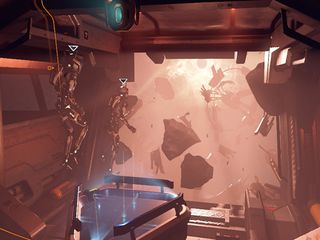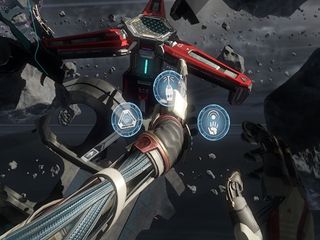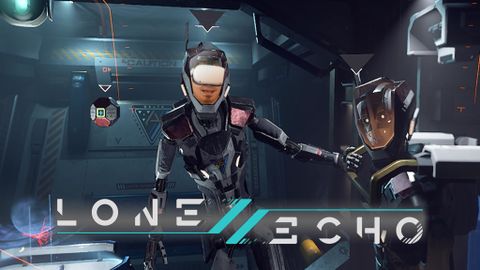
The original Lone Echo, a 2017 release, was one of the first "real games" I recall experiencing in VR. Up until then, with a few scattered exceptions, most VR games felt like experience pieces rather than full-scale games. It pioneered the feeling of zero gravity in VR — a feat that's not easy to achieve since your feet are still physically holding your body up from the floor — and the multiplayer component of the game was later spun off as its own title, Echo VR.
Sequels are notoriously difficult to make because, on all fronts, it's nearly impossible to live up to the expectation and newness that comes from an original IP. Four years later, however, Ready at Dawn studios has prepared a title that not only meets the original toe-to-toe in terms of originality and intrigue but bests it in every single way. It's a $40 direct sequel to the original Lone Echo, taking place immediately after the first game ends.
Lone Echo II is a title that holds its own even against heavy-hitters like Half-Life: Alyx and The Walking Dead: Saints & Sinners, and confidently sits alongside the best VR games as a must-play title if you have access to a VR-ready gaming PC.
I spent time to re-complete the original Lone Echo before delving into the sequel so I could adequately recall all the mechanics and story of the original. I played the entirety of the game on an Oculus Quest 2 using an Oculus Link cable and was given about one week to complete our Lone Echo II review.

Bottom line: Lone Echo II is a pristine example of how a sequel can be better than the original in every way. More mature and varied gameplay elements, impressive graphics, and a story that wouldn't feel out of the place in a novel make this the must-have swan song of the Rift platform.
For
- Brilliant story and dialog
- Impressively convincing zero-G controls
- Better gameplay variety than the original
- Gorgeous visuals and animation
Against
- Some strange, minor visual glitches
- Rift-platform exclusive
Disclaimer: This review was made possible by a review code provided by Oculus Studios. The company did not see the contents of the review before publishing.
Lone Echo II: A perfect sequel

Lone Echo II takes place directly after the end of the first game, but if you haven't played (or don't want to play) the original, don't worry. The beginning of the story mode presents you with a succinct retelling of the original tale, getting you up to speed in a matter of a minute or two. That's particularly nice because, like a Nintendo game, the original Lone Echo rarely goes on sale.
Just as in the original, you'll be playing as Jack, a utilitarian Echo robot unit that was designed to help accompany Liv, the game's main human protagonist.
| Category | Lone Echo II |
|---|---|
| Title | Lone Echo II |
| Developer | Ready at Dawn |
| Publisher | Oculus Studios |
| Genre | Adventure puzzler |
| Minimum requirements | Windows 10 Intel i7-6000 equivalent or greater NVIDIA GTX 1080 equivalent or greater 16GB RAM Oculus VR headset |
| Game size | 21GB |
| Play time | 10-15 hours |
| Players | Singleplayer |
| Launch price | $40 |
Jack has been out of commission for roughly four months after the end of the first game, giving a good excuse to either get oriented with the controls (if you're a first-time player) or skip through them entirely and get on with the story. Unlike the original title — which has you going through at least an hour of seemingly menial activities before the action heats up — Lone Echo II puts players in danger within 15 minutes of the game starting.
While some sequels tend to stick to familiar mechanics and just change up the scenery a bit, Lone Echo II completely flips the script on its head and introduces several new mechanics almost immediately. The most surprising of which is the inclusion of actual enemies that will attack you if you're not careful (or don't dispatch of them immediately).
That's a big change-up from the original in which the enemies mostly acted like the metal bits from the board game Operation, ensuring players would follow a path without touching the edges.
This time around, you'll need to fend off aggressive enemies who try to sap your power.
Having enemies that aggressively attack you sets the stage for bigger and scarier things to come in the universe, especially since 400 years have passed and these creatures apparently evolve rather quickly.
Initially, you'll only have environmental tools to deal with these enemies — so you'll need to pause a moment to think about how to wrangle these critters so they don't attack you — but that, too, changes quickly enough. Apparently, humans 400 years in the future have figured out new ways to outfit an old Echo unit; fitting since you'll also need these to solve new sorts of puzzles that present themselves along the way.
Just as Ready at Dawn evolved the gameplay in significant ways, the environments you'll traverse are proportionately larger in scope compared to the original. Sure, you could float around to quite a few different places in the first third of the original game, but those places were fairly small in size compared to what's in store for you in the sequel.




Just as Ready at Dawn evolved the gameplay in significant ways, the environments you'll traverse are proportionately larger in scope compared to the original.
Without spoiling anything, some of my very favorite parts of the game took place in the flashback sequences, helping fill out Jack's backstory and explore why in the world Jack seems to be malfunctioning so often. Elements from Echo VR are consistently pulled into the gameplay, further helping to add variation to an already impressively varied experience.
Like the original, you'll be spending the entirety of the game in zero gravity. Whether it's on a space station, ship, or out in space itself, the feeling of being in zero gravity is unbelievably immersive and, at least for me, seemed to pull me into the game even more than the original did. After several long play sessions, I found myself grabbing the edges of walls as I walked around my home as if I needed to do this to propel myself through the hall (as you do in the game).
Lending to the immersion are the improved visuals, which taxed my aging PC to its limits. I run a Core i7-8700K and an NVIDIA GeForce GTX 1080 Ti — which normally doesn't struggle even with demanding titles — but I had to run Lone Echo II at medium settings to achieve a consistent frame rate.
Even at low settings, the visuals are absolutely stunning.
Even at low, though, the enhanced visuals are stunning, and the animation on Liv's face is nothing short of movie quality. It really helps bring you into the world and feel like you're right there alongside her. Little details, like fingers adjusting automatically to how you grip objects, prove how much of a letter of love to the VR community this game really is.
Ready at Dawn also seems to have put some serious work into the audio dynamics throughout the game. As you enter larger ships and stations, Liv's voice will echo differently depending on what part of the station you're in. Even in the same large room, you'll hear nuance differences when you're in a smaller alcove versus the larger open space. It's incredible and, again, all lends to help make the player even more immersed into this well-crafted world.
Lone Echo II: Some minor complaints

As an Oculus Studios title, it should come as little surprise that you'll need an Oculus headset to play the game. If you don't have an Oculus headset, you'll need to install third-party software to gain access to your library of Rift games.
This is the Rift's swan song, but it still needs an Oculus headset to officially play.
It's not the end of the world, but it is an extra step and could always come with compatibility issues that, in my opinion, simply shouldn't exist on a PC platform. Lone Echo II is almost certainly the last Rift game developed by Oculus Studios, though, owing to the company's focus shifting to the standalone Oculus Quest family.
Despite using an official Oculus setup and meeting the system requirements for play, I still saw plenty of strange visual glitches while looking and floating around the world. Texture pop-in, hazy objects both distant and near, and some strange object jumping and shifting that looked to me to be the result of aggressive LODing or some similar system designed to keep the frame rate consistent.
If you're rocking a PC VR headset that's tethered, make sure you're using virtual turning often, as you'll most certainly get those cables tangled up in a game that takes place in zero gravity. Most movement is still handled by physical grabs and tosses, so reorienting yourself with the joysticks is important if you've got a cord on your back.
Lone Echo II: Should you play it?

Lone Echo II is 2021's Half-Life: Alyx in just about every way. It's a singleplayer experience that's simply unmatched in its scope, from the story to the environments, the puzzles, and the way you control your character. It's a game that wouldn't make sense without a VR headset and, because of that, it sits alongside the list of must-play titles.
Its biggest setback is that Lone Echo II is technically an Oculus Rift exclusive, meaning you can only buy and play it on the Rift app. Mods exist for letting players experience Rift games with a non-Oculus branded headset, but it's worth noting that you'll need to do some extra things to get it working. Since Ready at Dawn is an Oculus Studios company, there's little hope of this ever changing.
Outside of some platform complaints, there's really nothing Ready at Dawn could do to further improve or refine the Echo experience. This is Lone Echo perfected. It's bigger and badder, more varied, and has an even more compelling story than its predecessor. Have a VR-capable PC? Play this. Right now.

Bottom line: Lone Echo II builds upon the first game in every way, delivering better graphics, refined gameplay, brand-new mechanics, and ruthless enemies. Take an adventure around the rings of Saturn to finally discover the source of the biomass infection and learn a frightening story of humanity's frailty in the universe.
Nick started with DOS and NES and uses those fond memories of floppy disks and cartridges to fuel his opinions on modern tech. Whether it's VR, smart home gadgets, or something else that beeps and boops, he's been writing about it since 2011. Reach him on Twitter or Instagram @Gwanatu

